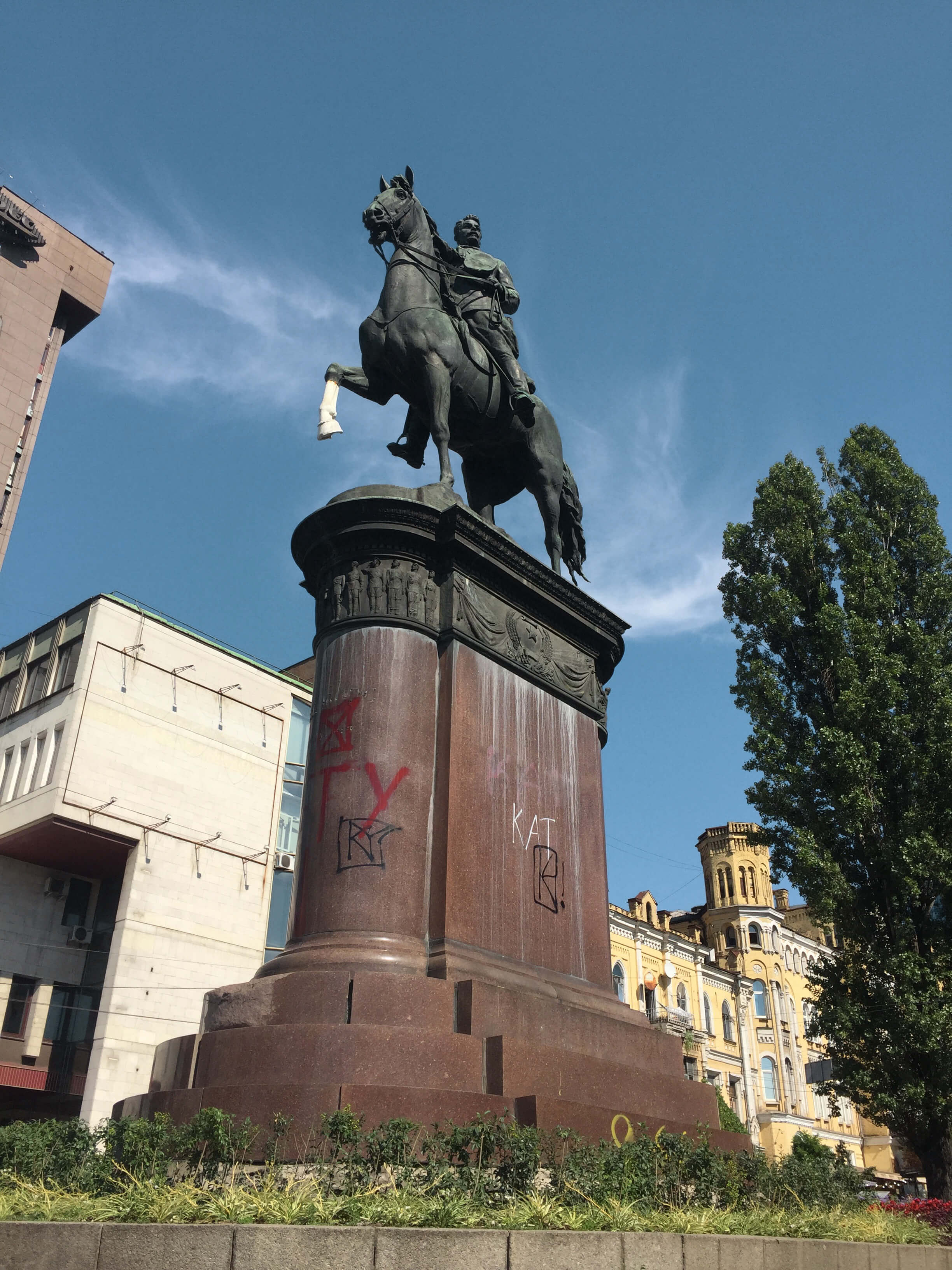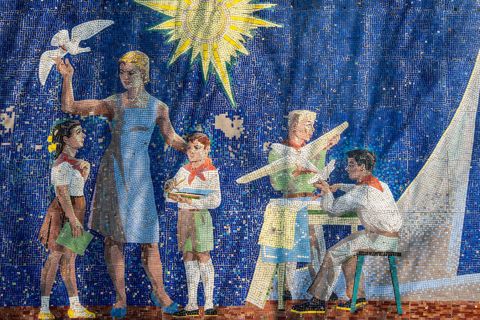
In Bucharest, Lenin Was Turned into a Hydra and a Red Foot: The Project Author on Her Bold Idea
In 1989, Romania was shaken by a revolution. The dictator Nicolae Ceaușescu, who had ruled the country for 24 years, was executed, and the monument to Vladimir Lenin in Bucharest was soon toppled as a symbol of the communist past.
For a long time, the pedestal in the heart of the capital remained empty, and the bronze Lenin by the sculptor Boris Karadzha lay abandoned near Mogoșoaia Palace just outside Bucharest. That changed in 2010, when artist Ioana Ciocan started her ambitious
Eventually, the artists began to join her. In four years, 20 sculptures appeared in the square one after another. Many of them were reimaginings of the image of the Soviet figure, while others, at first glance, seemed unrelated to him in any way, like, say, the red foot by artist Bogdan Rața.
In her interview with Bird in Flight, the artist, who currently teaches art history at the University of Bucharest, talks about what bothered her about the Romanians’ perception of their past and how her project helped her get rid of her fear of the specter of Communism.
American linguist James E. Young proposed the term “counter-monument” to talk about artists creating bizarre sculptures in contrast with traditional memorials. Counter-monuments aim to reject the ideological pathos of classic monuments in public places.
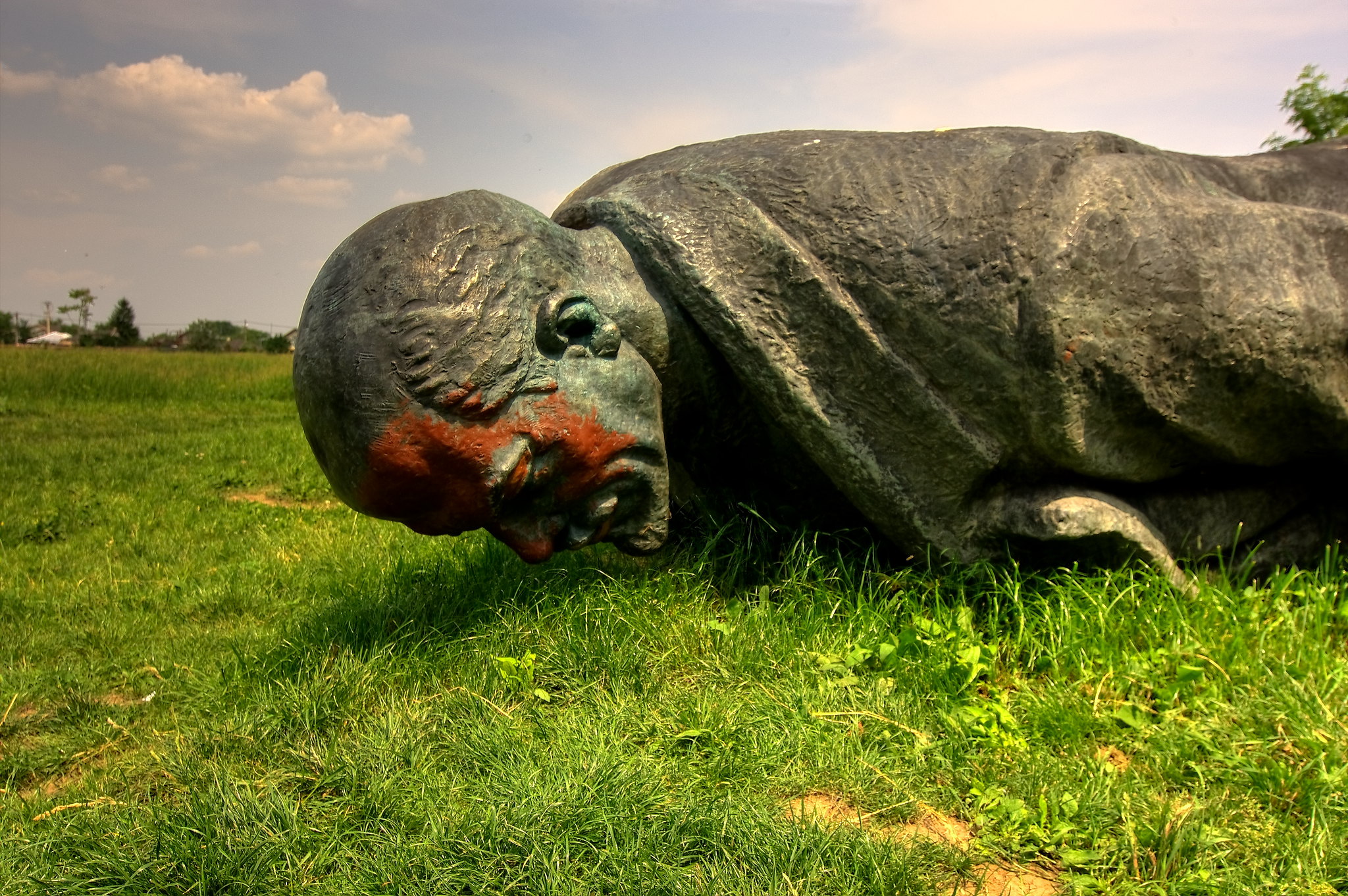
The Lenin monument that stood in Bucharest before 1990 is laying in Mogoșoaia Palace in Romania. Photo: Gaspar Serrano / Flickr
What kinds of events were taking place in Romania in 2010 to motivate you to start a project about the communist past twenty years after the regime was toppled?
The interest I take in communism is not purely political. The “1990” project is about how life under communism changed people anthropologically and culturally, and how it affected our relationships and the perception of art.
I am particularly interested in the phenomenon of swapping food: I still remember all the stories about how my mother would exchange socks for butter. There were also the lines: how come we would stand so close to each other in stores? What keeps the French from pushing the line with their elbows to get ahead? I also look at the propaganda machine and its relationship to advertising: fake news, how certain messages emerged, and how they changed mindsets.
The project itself began with the empty pedestal where the Lenin monument had stood before. Ceaușescu’s regime was very nationalistic: he did not want Russian influence in public art, so you won’t find many references to Russian leaders in Romania. We had a statue of Stalin for several years and only one monument to Lenin in the entire country. In 1990, after the revolution, the statue was removed, and until 2010, the pedestal remained empty.
Ceaușescu did not want Russian influence in public art, so we only had one monument to Lenin in the entire country.
The fact that it was empty all this time is also a sign that Romania has not been completely done with communism. For example, in Hungary, such memorials were moved to a designated park within a month. They had a discussion then on what should be done with this legacy, and not in friendly chats or anything, but in the parliament. We never got to have such a dialogue. So I decided to do something with this empty pedestal. Otherwise, I would be yet another Romanian woman who did nothing.
What was it that you didn’t like about society’s perception of their past?
The fact that we refused to acknowledge it. In my opinion, we had to follow the Hungarians’ suit: collect it and keep it. I will never accept that destroying monuments changes anything: for me, it is but a temporary solution. This only makes us forget about this past that we had.
The way I see it, some monuments should remain in place if only to be paired with explanations of what kind of person such-and-such was. This is how we can show that we want to know our past and would never let it repeat itself. Otherwise, the younger generations won’t have a clue about how dictatorship works.
How did you want to make a difference with your project?
While I still can tell who used to be on that pedestal, my students no longer can. They even have no idea what Lenin looked like. At first, I thought that the best solution would be to leave the pedestal empty as a sign that we have the freedom to remove someone from it or put anyone on it. It would symbolize the power of the people. But that would make it impossible to teach history through it.

Demolition of the Lenin monument in Bucharest on March 4, 1990. Photo: Andre Durand / AFP
What did you do then?
One half of my project is about the pedestal itself, and the other is about the monument. In 1990, the statue was toppled because the people refused to see any Russian symbols in their country, but the monument was soon forgotten. I decided to find out where it was. The statue was erected for the money my parents too paid from their taxes, and then it was just turned into trash. From an artistic point of view, this is unwise. It was there, outside, for twenty years. I decided that it should at least be given an inventory number and placed in a museum. This is not only the single monument to Lenin ever erected in Romania but also the work of the famous artist Boris Caragea.
I was in the DDR Museum in Berlin, which is split in two: one half is dedicated to the everyday lives of people, and the other, to the secret police and prisons. This is the kind of museum I’d like to see in Bucharest.
I got permission to use the statue and pedestal from the city council. It was not easy, but they understood that this was a work of art, which unfortunately happened to depict Lenin. I also started a petition for a museum of communism to be opened, although everyone told me that it was too early for a museum. That’s why I launched an art project, but no one wanted to put their statues there, because it was Lenin’s place. I decided I’d be the first.
My vision was to cover Lenin with bird food so that flocks of birds would sit on the statue: it would look like they were going to eat it. On Lenin’s head, I put a crown like the one put on the deceased for burial. And then released white doves because they were a symbol of peace under communism. So I buried Lenin.
I covered Lenin with bird food so that flocks of birds would sit on the statue: it would look like they were going to eat it. This allowed me to say to other artists, look, Lenin is no more.
This allowed me to say to other artists, look, Lenin is no more. After that, they agreed to use the space. Every sculpture spoke of the past: one, of the secret police, another, of the media, and yet another, of the freedom of expression.
All the works were quite large, but I raised funds for each from our sponsors. I got a polyester manufacturer to supply materials, looked for special tools. I don’t remember exactly how much it cost, but looking back, it wasn’t that expensive. After all, I was very young then and had not a penny to my soul.
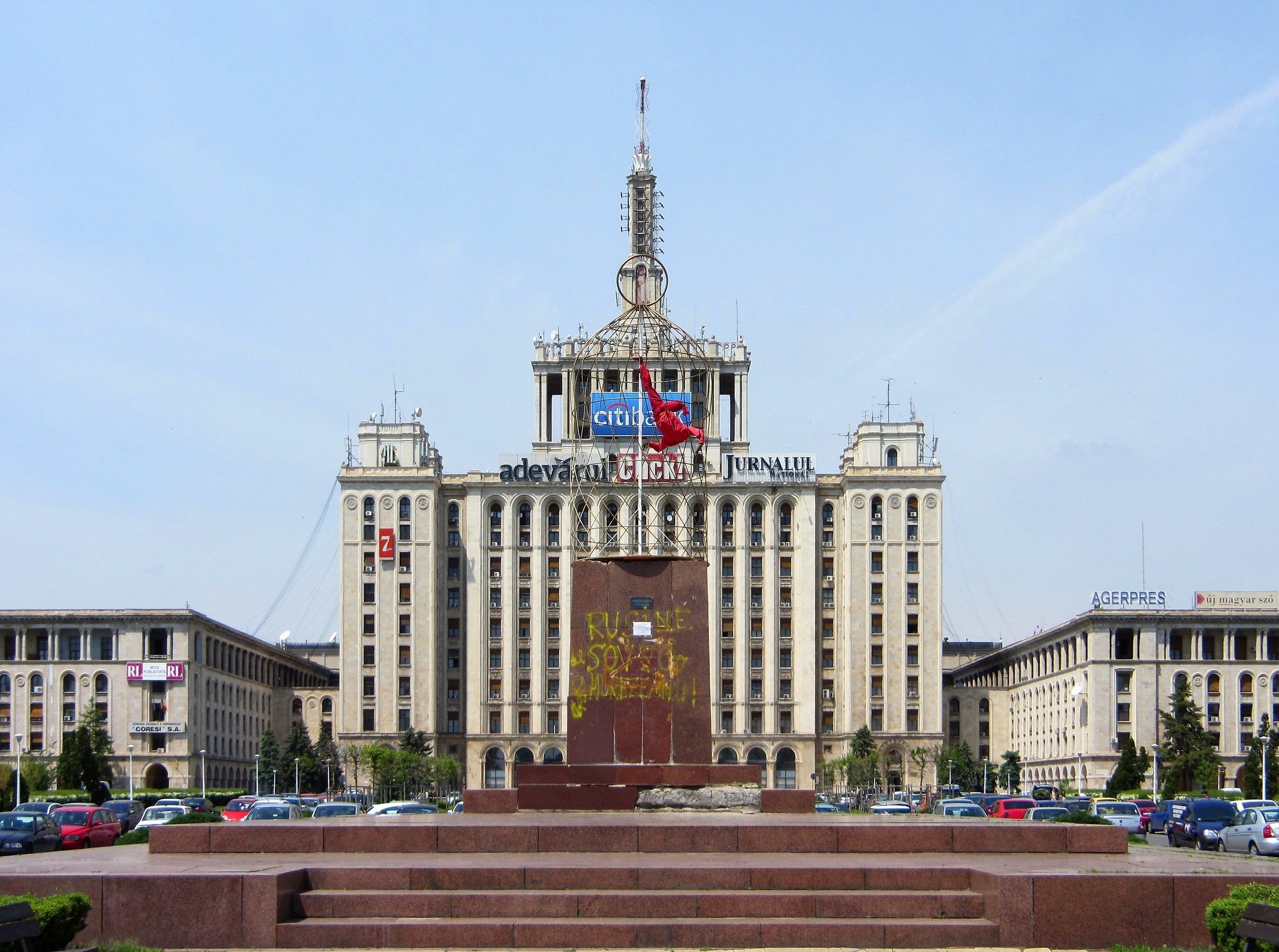
A cage with a red captive inside is the installation "Where are we?" by Ionuț Teodor Barba. Photo: Alexandru Panoiu/Flickr
Who spoke against the project, and who became a supporter?
The project turned out to be very popular. People realized that it was an issue that we had a five-meter-tall granite pedestal in the center of the city with no one ever asking why it was empty. It’s a Romanian thing: you just wait for someone to come and solve the problem.
I was getting threats, too: I even hired bodyguards in 2010. When I released the doves, passers-by started shouting that I wanted to bring back communism by putting Lenin back on the pedestal. I received emails from people calling me a communist and wishing me dead. But the media, which liked the project, helped a lot. For four years after that, journalists would call me and I would explain why this was art, and tell that the project was about freedom and not about Lenin. People died in the revolution for many causes: in a sense, one of them was my right to use Lenin’s image in art.
Did you manage to achieve everything you wanted?
Not quite. I still believe that there should be a museum, and I have not achieved that goal. But the minister of culture and the president sanctioned it, and I will be on the board. Now the institution is there, but no building. All in all, the project was a success, I think it made a big difference. Besides, it became the first public art space in Romania.

A sculpture of Lenin with seven roses instead of a head. Artist: Costin Ionita. Photo: George Moga / Flickr

A three-meter-tall statue of Lenin made of chocolate, rice, and candies, and installed on the site of the Lenin monument in Bucharest. Artist: Ioana Ciocan. Photo: Vadim Ghirda / AP Photo
Looking back twenty years later, what would you have done differently?
I would have adopted a more systematic approach. Maybe the project was a success exactly because I had no plan, but I was swamped with work back then. As for the meanings, I wouldn’t have changed anything.
As far as I know, nostalgia for the communist past still sells quite well in Romania: there are goods styled to evoke this, themed parties taking place. How do you feel about it?
This does exist, but it is an inherent part of human nature. The older generation remembers only good things, like employment or free healthcare. This is what nostalgia is. Young people, on the other hand, know nothing about our communist past whatsoever. When I ask who Ceausescu was, only one student can answer out of the entire group.
What do you think about the blue hand installed in Kyiv, in the Bessarabska Square? The artist who created it, Bogdan Rața, also participated in your project, when he installed a red foot on the pedestal.
The red foot had meaning and was created especially for the pedestal in Bucharest. I cannot say I love the installation in Kyiv, but Bogdan Rața is a great sculptor. The work itself looks good.
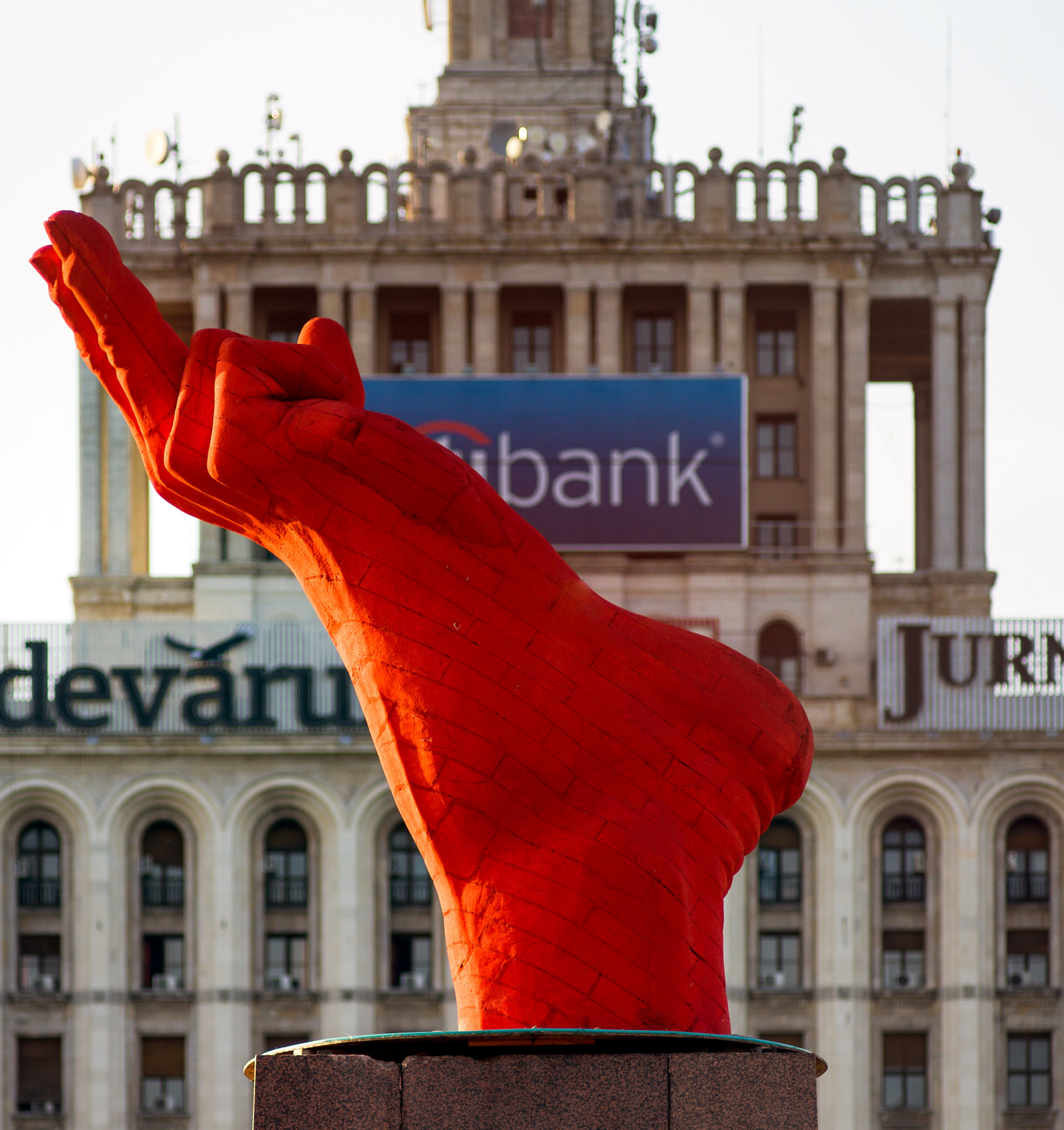
Bogdan Rața's sculpture at the site of the Lenin monument in Bucharest. Photo: Paul Chiorean / Flickr
Photo: a sculpture of Lenin with seven roses instead of a head. Artist: Costin Ionita.
New and best
